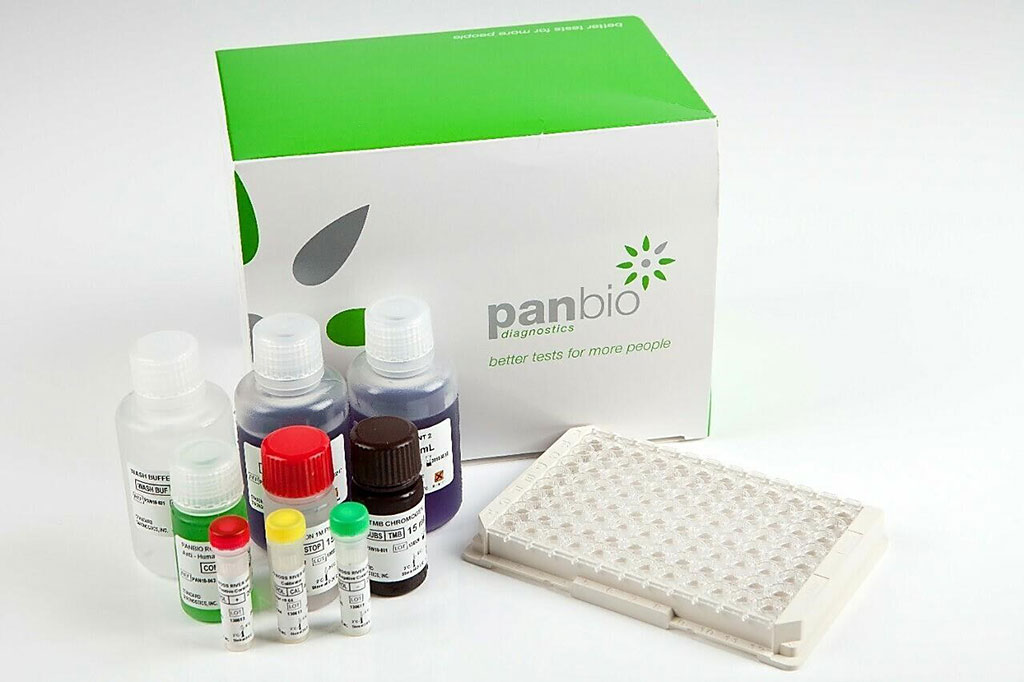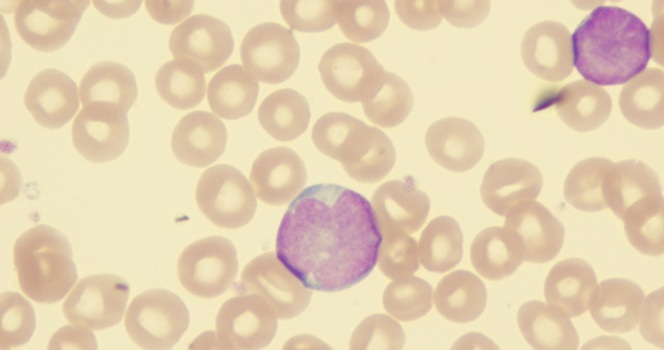Leptospira IgM ELISA Evaluated Among Outpatients in Southern Asia
|
By LabMedica International staff writers Posted on 26 May 2021 |

Image: The Leptospira ELISA IgM assay (Photo courtesy of Panbio)
Leptospirosis is a widespread but neglected zoonotic disease caused by a bacterium of the genus Leptospira. Leptospirosis contributes to approximately 48,000 annual deaths globally, with 500,000 cases estimated worldwide, and remains a major public health concern in tropical and subtropical regions. Weil’s disease is a severe form of leptospirosis.
The serological “gold standard” for identifying pathogenic Leptospira is the microscopic agglutination test (MAT); however, it requires significant technical expertise and the maintenance of viable Leptospira serovars. Microscopic agglutination test is often not beneficial for acute patient management, mainly because it relies on immunoglobulins which react five days after the exposure.
Tropical Medicine specialists at Mahidol University (Salaya, Thailand) and their international colleagues evaluated a Leptospira ELISA IgM assay among 656 febrile outpatients attending primary care in Chiangrai, Thailand, and Hlaing Tha Yar, Yangon, Myanmar. Inclusion criterion was a documented fever (tympanic temperature > 37.5°C) or a complaint of acute fever (< 14 days). Of primary care children and adults recruited in the original trial, 799 were randomized in a control group for whom various samples were collected. From these 799 outpatients, 740 had a blood sample collected.
A commercial Leptospira ELISA IgM assay (Panbio Pty., Ltd., Windsor, Australia) was used for the detection of IgM antibodies against Leptospira spp. The manufacturer’s specifications were followed with Panbio units of ≥ 11.0 considered positive. Positive Leptospira IgM ELISA samples were then tested by MAT, with titers of ≥ 1:100 used to classify past exposure to leptospirosis. TaqMan Array Card (TAC) and single-plex PCR assays were performed on 601 blood samples where sufficient plasma volumes were able to be extracted. The TAC assay targeted all pathogenic serovars of the Leptospira genus, whereas the single-plex PCR used real-time methodology to target the rss gene.
The team reported that the ELISA demonstrated limited diagnostic accuracy for the detection of acute leptospiral infection using the manufacturer recommended cutoff, with a sensitivity of 71.4% and specificity of 36.4%, and an area under the receiver operator characteristic curve value of 0.65, compared with the reference test, the PCR assay. ELISA also performed poorly as a screening tool for detecting recent exposure to Leptospira spp. compared with the “gold-standard” MAT, with a specificity of 42.7%. The proportion of patients with a confirmed acute leptospirosis infection as defined by either single-plex or TAC PCR assay was 1.1% (7/656), whereas 23.5% (154/656) were seropositive by IgM ELISA.
The authors concluded that the IgM ELISA, although simple and widely used, was found to be unsuitable for detecting acute leptospirosis infection among outpatient children and adults attending primary care, using PCR assays as a reference method Even so, it is unlikely that such test, used on an acute sample, may represent an attractive candidate for the diagnosis of acute leptospirosis. The IgM ELISA was not specific as a screening method for recent exposure to pathogenic Leptospira. Using the MAT, the scientists demonstrated a significant exposure (30.5%) to pathogenic Leptospira among Thai and Myanmar communities, including rural and semi-urban settings. The study was published on May 5, 2021 in The American Journal of Tropical Medicine and Hygiene.
Related Links:
Mahidol University
Panbio Pty., Ltd
The serological “gold standard” for identifying pathogenic Leptospira is the microscopic agglutination test (MAT); however, it requires significant technical expertise and the maintenance of viable Leptospira serovars. Microscopic agglutination test is often not beneficial for acute patient management, mainly because it relies on immunoglobulins which react five days after the exposure.
Tropical Medicine specialists at Mahidol University (Salaya, Thailand) and their international colleagues evaluated a Leptospira ELISA IgM assay among 656 febrile outpatients attending primary care in Chiangrai, Thailand, and Hlaing Tha Yar, Yangon, Myanmar. Inclusion criterion was a documented fever (tympanic temperature > 37.5°C) or a complaint of acute fever (< 14 days). Of primary care children and adults recruited in the original trial, 799 were randomized in a control group for whom various samples were collected. From these 799 outpatients, 740 had a blood sample collected.
A commercial Leptospira ELISA IgM assay (Panbio Pty., Ltd., Windsor, Australia) was used for the detection of IgM antibodies against Leptospira spp. The manufacturer’s specifications were followed with Panbio units of ≥ 11.0 considered positive. Positive Leptospira IgM ELISA samples were then tested by MAT, with titers of ≥ 1:100 used to classify past exposure to leptospirosis. TaqMan Array Card (TAC) and single-plex PCR assays were performed on 601 blood samples where sufficient plasma volumes were able to be extracted. The TAC assay targeted all pathogenic serovars of the Leptospira genus, whereas the single-plex PCR used real-time methodology to target the rss gene.
The team reported that the ELISA demonstrated limited diagnostic accuracy for the detection of acute leptospiral infection using the manufacturer recommended cutoff, with a sensitivity of 71.4% and specificity of 36.4%, and an area under the receiver operator characteristic curve value of 0.65, compared with the reference test, the PCR assay. ELISA also performed poorly as a screening tool for detecting recent exposure to Leptospira spp. compared with the “gold-standard” MAT, with a specificity of 42.7%. The proportion of patients with a confirmed acute leptospirosis infection as defined by either single-plex or TAC PCR assay was 1.1% (7/656), whereas 23.5% (154/656) were seropositive by IgM ELISA.
The authors concluded that the IgM ELISA, although simple and widely used, was found to be unsuitable for detecting acute leptospirosis infection among outpatient children and adults attending primary care, using PCR assays as a reference method Even so, it is unlikely that such test, used on an acute sample, may represent an attractive candidate for the diagnosis of acute leptospirosis. The IgM ELISA was not specific as a screening method for recent exposure to pathogenic Leptospira. Using the MAT, the scientists demonstrated a significant exposure (30.5%) to pathogenic Leptospira among Thai and Myanmar communities, including rural and semi-urban settings. The study was published on May 5, 2021 in The American Journal of Tropical Medicine and Hygiene.
Related Links:
Mahidol University
Panbio Pty., Ltd
Latest Immunology News
- New Test Distinguishes Vaccine-Induced False Positives from Active HIV Infection
- Gene Signature Test Predicts Response to Key Breast Cancer Treatment
- Chip Captures Cancer Cells from Blood to Help Select Right Breast Cancer Treatment
- Blood-Based Liquid Biopsy Model Analyzes Immunotherapy Effectiveness
- Signature Genes Predict T-Cell Expansion in Cancer Immunotherapy
- Molecular Microscope Diagnostic System Assesses Lung Transplant Rejection
- Blood Test Tracks Treatment Resistance in High-Grade Serous Ovarian Cancer
- Luminescent Probe Measures Immune Cell Activity in Real Time
- Blood-Based Immune Cell Signatures Could Guide Treatment Decisions for Critically Ill Patients
- Novel Tool Predicts Most Effective Multiple Sclerosis Medication for Patients
- Companion Diagnostic Test for CRC Patients Identifies Eligible Treatment Population
- Novel Tool Uses Deep Learning for Precision Cancer Therapy
- Companion Diagnostic Test Identifies HER2-Ultralow Breast Cancer and Biliary Tract Cancer Patients
- Novel Multiplex Assay Supports Diagnosis of Autoimmune Vasculitis
- Blood Test Predicts Immunotherapy Efficacy in Triple-Negative Breast Cancer
- Simple Genetic Testing Could Predict Treatment Success in Multiple Sclerosis Patients
Channels
Clinical Chemistry
view channel
Chemical Imaging Probe Could Track and Treat Prostate Cancer
Prostate cancer remains a leading cause of illness and death among men, with many patients eventually developing resistance to standard hormone-blocking therapies. These drugs often lose effectiveness... Read more
Mismatch Between Two Common Kidney Function Tests Indicates Serious Health Problems
Creatinine has long been the standard for measuring kidney filtration, while cystatin C — a protein produced by all human cells — has been recommended as a complementary marker because it is influenced... Read moreMolecular Diagnostics
view channel
Simple Urine Test to Revolutionize Bladder Cancer Diagnosis and Treatment
Bladder cancer is one of the most common and deadly urological cancers and is marked by a high rate of recurrence. Diagnosis and follow-up still rely heavily on invasive cystoscopy or urine cytology, which... Read more
Blood Test to Enable Earlier and Simpler Detection of Liver Fibrosis
Persistent liver damage caused by alcohol misuse or viral infections can trigger liver fibrosis, a condition in which healthy tissue is gradually replaced by collagen fibers. Even after successful treatment... Read moreHematology
view channel
Platelet Activity Blood Test in Middle Age Could Identify Early Alzheimer’s Risk
Early detection of Alzheimer’s disease remains one of the biggest unmet needs in neurology, particularly because the biological changes underlying the disorder begin decades before memory symptoms appear.... Read more
Microvesicles Measurement Could Detect Vascular Injury in Sickle Cell Disease Patients
Assessing disease severity in sickle cell disease (SCD) remains challenging, especially when trying to predict hemolysis, vascular injury, and risk of complications such as vaso-occlusive crises.... Read more
ADLM’s New Coagulation Testing Guidance to Improve Care for Patients on Blood Thinners
Direct oral anticoagulants (DOACs) are one of the most common types of blood thinners. Patients take them to prevent a host of complications that could arise from blood clotting, including stroke, deep... Read moreImmunology
view channel
New Test Distinguishes Vaccine-Induced False Positives from Active HIV Infection
Since HIV was identified in 1983, more than 91 million people have contracted the virus, and over 44 million have died from related causes. Today, nearly 40 million individuals worldwide live with HIV-1,... Read more
Gene Signature Test Predicts Response to Key Breast Cancer Treatment
DK4/6 inhibitors paired with hormone therapy have become a cornerstone treatment for advanced HR+/HER2– breast cancer, slowing tumor growth by blocking key proteins that drive cell division.... Read more
Chip Captures Cancer Cells from Blood to Help Select Right Breast Cancer Treatment
Ductal carcinoma in situ (DCIS) accounts for about a quarter of all breast cancer cases and generally carries a good prognosis. This non-invasive form of the disease may or may not become life-threatening.... Read morePathology
view channel
Tunable Cell-Sorting Device Holds Potential for Multiple Biomedical Applications
Isolating rare cancer cells from blood is essential for diagnosing metastasis and guiding treatment decisions, but remains technically challenging. Many existing techniques struggle to balance accuracy,... Read moreAI Tool Outperforms Doctors in Spotting Blood Cell Abnormalities
Diagnosing blood disorders depends on recognizing subtle abnormalities in cell size, shape, and structure, yet this process is slow, subjective, and requires years of expert training. Even specialists... Read moreTechnology
view channel
Artificial Intelligence Model Could Accelerate Rare Disease Diagnosis
Identifying which genetic variants actually cause disease remains one of the biggest challenges in genomic medicine. Each person carries tens of thousands of DNA changes, yet only a few meaningfully alter... Read more
AI Saliva Sensor Enables Early Detection of Head and Neck Cancer
Early detection of head and neck cancer remains difficult because the disease produces few or no symptoms in its earliest stages, and lesions often lie deep within the head or neck, where biopsy or endoscopy... Read moreIndustry
view channel
Abbott Acquires Cancer-Screening Company Exact Sciences
Abbott (Abbott Park, IL, USA) has entered into a definitive agreement to acquire Exact Sciences (Madison, WI, USA), enabling it to enter and lead in fast-growing cancer diagnostics segments.... Read more









 assay.jpg)













